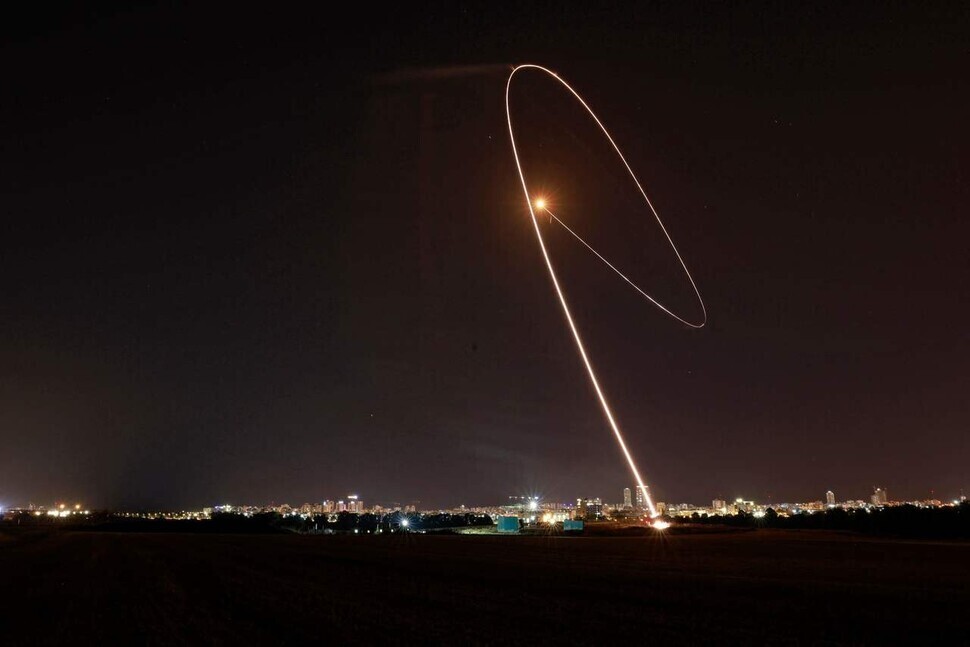hankyoreh
Links to other country sites 다른 나라 사이트 링크
[Column] Is S. Korea helpless against N. Korean artillery without Iron Dome?

A major focus of attention during this month's clash between Israel and the Palestinian group Hamas was the Iron Dome, an Israeli rocket interception system.
The Israeli Ministry of Defense shared footage of an interception, claiming that the Iron Dome had intercepted over 90% of rockets fired by Hamas.
Many South Koreans who saw the video shared the same response: envy. "We need to hurry up and get our own Iron Dome," they insisted, fretting over the lack of practical means of intercepting North Korean long-range artillery. Many media reports fell along the same lines.
Does South Korea's lack of an "Iron Dome" actually leave it helpless against North Korea's long-range artillery?
Before tackling this question, let's first consider the Iron Dome's interception success rate. Israel claims that it has intercepted over 90% of Palestinian rockets over the course of several clashes in the Gaza region since the Iron Dome was set up in 2011.
Some experts have argued that a precise calculation of the rocket interception rate is impossible, estimating the actual Iron Dome interception rate at somewhere between 59% and 75%.
The US magazine Bloomberg Businessweek raised questions about the 90% interception rate back in 2014, indicating in its report that Israel's low rate of civilian losses was because of the weakness of Hamas rockets and the effective warning systems and evacuation facilities in place in Israel.
During another clash in May 2019, the Israeli military said it had intercepted 240 out of 690 Palestinian rockets, or 29%. It remains unclear whether the claims of a "90% success rate" for Iron Dome interceptions are accurate or false advertising.
Some have insisted that aside from any questions about the actual accuracy rate, South Korea needs the battle-tested Iron Dome to allay the public's concerns about the lack of other means of intercepting North Korean long-range artillery.
Indeed, South Korean military authorities considered introducing an Iron Dome in the wake of the artillery attack on Yeonpyeong Island in November 2010. They ultimately deemed it inappropriate, concluding that it was "not suited to the Korean Peninsula battlefield environment."
There is no real comparison between the feeble weaponry of Hamas and the massive military might of North Korea. Hamas reportedly launched some 4,300 rockets over 10 days in the latest clash. That averages out of 430 rockets per day, or 18 per hour.
The North Korean military reportedly can launch 16,000 rounds of long-range artillery per hour. In terms of hourly scale (interception targets), North Korean artillery outweighs Hamas rockets by a factor of 889.
If Hamas rockets are a sprinkle of rain, North Korean long-range artillery is a downpour situation. Compared with the odd Hamas rocket, the defensive capabilities of an Iron Dome would be drastically diminished in a situation where North Korean long-range artillery is raining down on the greater Seoul area.
So are we helpless against a North Korean artillery attack without an Iron Dome? We are not.
There are two primary responses to long-range artillery: interceptions and strikes. Interceptions involve firing one's own shells to hit the incoming shells, as the Iron Dome does. Strikes involve destroying the artillery itself, using means such as cannons, rockets, missiles and fighter aircraft.
Even if we managed a 100% interception rate with North Korean long-range artillery shells, they could continue coming in if the equipment remains intact. In a battlefield environment like the Korean Peninsula, strikes aimed at eliminating the actual artillery are a more effective approach than intercepting shells.
Since the early 1990s, South Korea and the US have been developing "counterfire warfare" measures to neutralize North Korean long-range artillery in the event of an emergency.
In the beginning, they adopted a more defensive approach, which involved identifying the location from which North Korea was launching artillery by tracking the shells with counter-battery radar, and then attacking the battery.
Since 2010, a more aggressive approach has been adopted. While the objective of counterfire warfare before 2010 was to destroy 70% of long-range artillery within three days, the current objective is over 90% destruction within an hour.
South Korea and the US monitor North Korean long-range artillery movements around the clock. If they did detect evidence that a North Korean attack was imminent, they would go into aggressive counterfire warfare mode, striking first before the North has the chance to launch its artillery.
The caves where North Korean large-range artillery is based would be destroyed by South Korean and US fighters and artillery (including self-propelled artillery and multiple long-range launchers) and Korean Tactical Surface-to-Surface Missiles.
If additional shells are launched by any remaining long-range artillery, that would trigger reactive counterfire, where South Korean and US counter-battery radar would trace the position of the battery for destruction. It would reportedly take about half a day for North Korea's long-range artillery to be neutralized.
The South Korean Ministry of National Defense decided last year to begin developing a Korean model of the Iron Dome. The objective is to protect major infrastructure against counterstrikes by any North Korean long-range artillery not eliminated by the aggressive counterfire warfare approach.
Some have raised questions about the effectiveness of this decision, which is skewed toward "absolute security."
South Korea and Israel face different security threats. Accordingly, our methods of response are also different. The grass always looks greener in other pastures, so it appears to be with Israel's Iron Dome.

By Kwon Hyuk-chul, editorial writer
Please direct comments or questions to [english@hani.co.kr]

Editorial・opinion
![[Guest essay] The real reason Korea’s new right wants to dub Rhee a founding father [Guest essay] The real reason Korea’s new right wants to dub Rhee a founding father](https://flexible.img.hani.co.kr/flexible/normal/500/300/imgdb/original/2024/0423/8317138574257878.jpg) [Guest essay] The real reason Korea’s new right wants to dub Rhee a founding father
[Guest essay] The real reason Korea’s new right wants to dub Rhee a founding father![[Column] ‘Choson’: Is it time we start referring to N. Korea in its own terms? [Column] ‘Choson’: Is it time we start referring to N. Korea in its own terms?](https://flexible.img.hani.co.kr/flexible/normal/500/300/imgdb/original/2024/0423/3617138579390322.jpg) [Column] ‘Choson’: Is it time we start referring to N. Korea in its own terms?
[Column] ‘Choson’: Is it time we start referring to N. Korea in its own terms?- [Editorial] Japan’s rewriting of history with Korea has gone too far
- [Column] The president’s questionable capacity for dialogue
- [Column] Are chaebol firms just pizza pies for families to divvy up as they please?
- [Column] Has Korea, too, crossed the Rubicon on China?
- [Correspondent’s column] In Japan’s alliance with US, echoes of its past alliances with UK
- [Editorial] Does Yoon think the Korean public is wrong?
- [Editorial] As it bolsters its alliance with US, Japan must be accountable for past
- [Guest essay] Amending the Constitution is Yoon’s key to leaving office in public’s good graces
Most viewed articles
- 1[Column] ‘Choson’: Is it time we start referring to N. Korea in its own terms?
- 2Why Korea shouldn’t welcome Japan’s newly beefed up defense cooperation with US
- 3Senior doctors cut hours, prepare to resign as government refuses to scrap medical reform plan
- 4[Guest essay] The real reason Korea’s new right wants to dub Rhee a founding father
- 5Samsung barricades office as unionized workers strike for better conditions
- 6Opposition calls Yoon’s chief of staff appointment a ‘slap in the face’
- 7[Column] The clock is ticking for Korea’s first lady
- 8[Editorial] Japan’s rewriting of history with Korea has gone too far
- 9New AI-based translation tools make their way into everyday life in Korea
- 10Terry Anderson, AP reporter who informed world of massacre in Gwangju, dies at 76